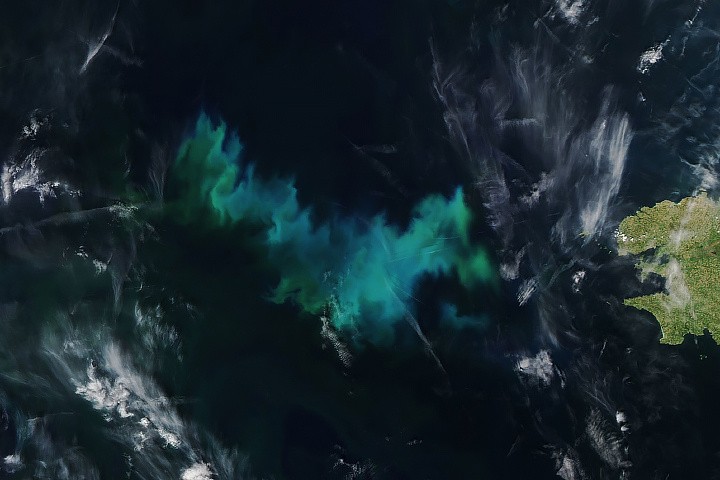NASA observed an enchanting sight in the Celtic Sea during spring 2024 - a vast expanse of light greens and blues billowing across the water's surface.

A Phytoplankton Bloom in the Celtic Sea
This phenomenon, known as a phytoplankton bloom, unfolded as the warming of surface waters and increased sunlight created optimal conditions for these tiny plant-like organisms to thrive.
This natural phenomenon is characterized by the rapid proliferation of microscopic plant-like organisms called phytoplankton in aquatic environments, particularly in oceans and seas.
According to NASA, these blooms occur when conditions become favorable for phytoplankton growth, including ample sunlight, carbon dioxides, and nutrient availability, such as nitrogen and phosphorus.
As phytoplankton populations rapidly increase, they can form dense patches or layers near the ocean's surface, often visible as water discoloration.
The composition and characteristics of phytoplankton blooms can vary depending on water temperature, nutrient levels, and species diversity, contributing to ocean ecosystems' dynamic and interconnected nature.
NASA Aqua Captures a Vibrant Display in the Celtic Sea
Satellites tracked the evolution of this vibrant display for over a week before NASA's Aqua satellite, equipped with the MODIS (Moderate Resolution Imaging Spectroradiometer), captured a striking natural-color image on May 10.
Phytoplankton are microscopic organisms that share similarities with plants. According to NASA, their proliferation plays a fundamental role in marine ecosystems, sustaining a diverse range of aquatic life, from microscopic zooplankton to larger shellfish and finfish.
As temperatures rise and sunlight intensifies during the spring and early summer, northern seas such as the Celtic Sea become fertile grounds for these spectacular blooms.
NASA notes that in the initial stages of the season, diatoms dominate. They are characterized by their silica shells and rich chlorophyll content, which impart a lush green hue to the surface waters.
As the water column stratifies with warming, coccolithophores—phytoplankton encased in reflective calcium carbonate plates—become prevalent, casting a milky turquoise-blue sheen over the ocean's surface.
Read Also : NASA James Webb Space Telescope Maps the Weather of Hot Gas-Giant Exoplanet 280 Light-Years Away
A Blend of Greens and Blues
The distinctive blend of greens and blues observed in this bloom may arise from a medley of phytoplankton species or colored dissolved organic matter, which can alter seawater's appearance, ranging from green to yellow-green or sometimes brown, depending on concentration levels.
Traditionally, identifying specific phytoplankton species within blooms has relied on analyzing water samples collected from the ocean. However, recent advancements in satellite technology offer promising prospects for remotely discerning phytoplankton types.
NASA's PACE (Plankton, Aerosol, Cloud, ocean Ecosystem) satellite, equipped with the Ocean Color Instrument (OCI), launched in February 2024, is poised to revolutionize how phytoplankton dynamics are understood by detecting hundreds of wavelengths of light and potentially revealing the species makeup of blooms like the one observed in the Celtic Sea.
Related Article : NASA's Hubble Space Telescope Captures 'Butterfly Nebula' In Stunning Motion | Fun Facts About This Beautiful Space Butterfly

ⓒ 2026 TECHTIMES.com All rights reserved. Do not reproduce without permission.




